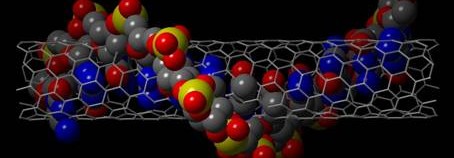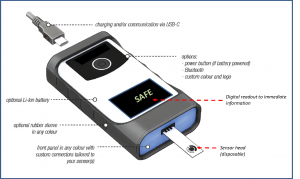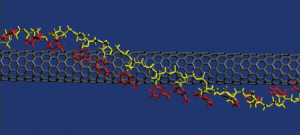Technology
In contrast with competitors who are developing point of use devices via complex, expensive miniaturisation of existing laboratory processes, Sapient Sensors has adopted a radically different, yet intrinsically elegant, approach. Its device integrates aptamer molecular recognition with solid state nanoscale electronics and flexible printed electronics.
Sapient Sensors device consists of three elements:
- A disposable customised target sensor consisting of measurement and reference electrodes (Fig. 1.)
Figure 1
- A hand-held reader into which the sensing element is fitted. Suitable readers are commercially available (Fig. 2.)
Figure 2
- An output device capable of reading the output signal from the reader. This may be a smart phone (Fig. 3.)
Figure 3
Target molecules (“analytes”) bind to cognate ligands of the sensing element in the manner of a “key” fitting into a “lock”. When the key enters the “lock” an electrical signal is generated and detected by the reader. In previous device designs this signal has often been obscured by “non-specific binding” (NSB) of non-target molecules to the sensor. The proprietary reference electrode system of the Sapient Sensors device cancels out the binding of non-target molecules, delivering a “clean” signal.
Both the measurement and reference electrodes of the device consist of an active element (Fig. 4.), an aptamer or antibody, attached to a carbon nanotube as part of a miniature printed circuit. Charge is transferred when a target molecule is captured by the active element of the measurement electrode. The reference electrode to which target molecules cannot bind exists to “normalise” the measurement.
Figure 4
Competitive Advantage
Sapient Sensors’ technology delivers:
- Accessibility via measurement that does not require operator-dependent sample processing, allowing unskilled operators to specifically detect target molecules at the point of use using an inexpensive hand-held reader.
- Increased discrimination and accuracy enabled by proprietary internal reference technology (US 9,753,031 B2, granted; US 2017/0370918A1, pending) that essentially cancels out artefacts arising from non-specific binding.
- Increased efficiency through the simplicity of direct electrical detection of target molecules.
- Increased speed of response through the rapid kinetics enabled by nanoscale carbon nanotubes (CNT), providing the ability to rapidly detect a positive result.
Stage of Development
Sapient Sensors has patented its device extensively. Its patent (PCT/GB2012/050745 with a priority date of 31/03/2011 is granted in the EU (Denmark, France, Germany, Ireland, Italy, Netherlands, Poland, Spain and UK), China, Japan, Russia and US and is pending in India. A second US method patent (US 2017/0370918A1) was filed in August 2017 with a priority date of April 2 2012.
Sapient Sensors has developed its device from laboratory concept to prototyped manufacture on polyester substrate using Thrombin as the target molecule. During this journey, the capability of the device has been extended from multiplex qualitative to quantitative measurement. Quantitative responses have been detected at concentrations as low as 1pg/mL and it is anticipated that yet lower limits of detection are feasible.
Products
Sapient Sensors is currently working with partners to develop products for Food and Human Healthcare applications.





